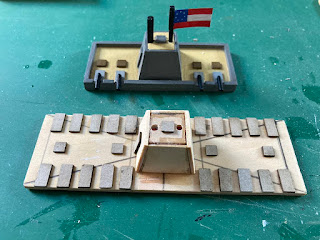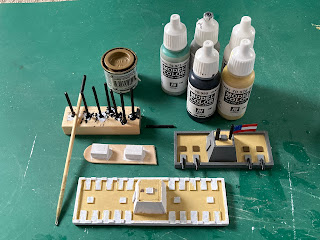A Unions drone’s eye view
OK, I know, I know - I said that I would build one at some point BUT - that point arrived much sooner than expected!
I have spent some unexpected free time working on the sister ship to the CSS Memphis - the CSS New Orleans. It was a fiddly build for sure - mainly due to the close proximity of the guns to one another - but I am pleased to have tackled it as it will be useful for river actions.
All the gun carriages in place, two sets of deck hatches and the central citadel. The CSS Memphis gives an idea of what the CSS New Orleans will look like.
The next step was to add the gunwales - this was a fiddly job for sure! The citadel was quite straightforward and used as the core an old, 1970s vintage wooden D6.
Prior to painting - the two rectangular blocks in the centre foreground are the deck houses that were placed either side of the citadel. The forest of cocktail sticks mounted on the Jenga block turned into gun barrels - the black length you see to the right of the block is now the flagstaff. The bamboo barbecue skewer - at least the white end of it - is now the ‘funnel’. Note the two deck houses in the foreground - these will be added to the model once painted.
This was another fiddly part - painting the gun carriages. When I say fiddly it is probably relative as a better painter than I would have little difficulty this phase - it is all the ‘cutting in’ that is, for me, tedious!
The gunwales and viewing hatch on the top of the central citadel are now painted. The two deck houses have also had the first part of their paint job attended to. Next up will be the central citadel, the four deck hatches and the two deck houses will get their roofs painted. Once that is done I will varnish the entire model prior to adding the gun barrels, funnel and flagstaff.
Nearly there! The two deck houses are now in place, along with the funnel and flagstaff. I will varnish this and then add the gun barrels and the all important flag - that is first picture on this post.
Rebel defences - a coastal fort and a pair of floating batteries. I need to think about a river fort but this lot will do for now methinks!
The ‘hull’ for this model was fashioned from basswood as I did not have any MDF of a suitable size as it is larger than my MDF hull template supply measuring as it does some 11 cm by 3.5 cm. The central citadel on both models has an old D6 at the core - when I say old I mean 1960s vintage with the ‘dots’ barely visible - with wooden craft stick sides. The gunwales are made from 3mm square balsa wood strip, the gun carriages from 10mm by 5mm grey card, the deck hatches and observation port (on the top of the central citadel) from 5mm square pieces of card, the gun barrels and flagstaffs are from cocktail sticks and the ‘funnel’ is from a bamboo barbecue skewer. The two deck houses are from basswood strip.
Painting was straightforward but, as mentioned, fiddly due to the number of tight places that the brush had to go. The end result though, was definitely worth it. The Confederate part of the collection at last has some meaningful defences to use.
The Final, Final, Final Piece(s)…..
A chance remark by me to David Manley about how both of these two floating batteries seemed to resemble ironclads led me to think about the Union ‘Black Terror’ - a dummy ironclad built from timber used to scare off the Confederates attempting to salvage the grounded USS Indianola. Needless to say you can probably guess what is coming next….
I shall be building the USS Indianola and the ‘Black Terror’ - the former I had plans to tackle at some point to round out the Union river ironclads in my collection - at some point. Mr Manley sent me copies of the pictures he uses to advertise his STL files on Wargame Vault as part of the conversation so my fate was effectively sealed….
By way of a ‘one-two’ I also had the pleasure of finally speaking with that well known ‘purveyor of projects and painter of aircraft/ships/figures/vehicles (delete as appropriate!)’ the blogging legend that is Jim Jackaman. We spoke of matters many and varied and during the conversation the subject of Union ironclad the USS Choctaw came about.
Believe it or not but this rather handsome model was made from paper! The USS Choctaw - now that is an ironclad!
We both agreed that this is a fine looking vessel for sure but also that some of the curves would be tricky to accommodate. Needless to say after the conversation had finished - he really is a most delightful chap - I made the fatal mistake of looking into the USS Choctaw….you can probably guess the inevitable outcome of all this.
I cannot in all conscience blame either Mr Manley or Mr Jackaman for their subliminal encouragement - at least not at the moment anyway although when I get snarled up in a particularly tricky of the construction I may think otherwise! ;-)
Thanks chaps!





























